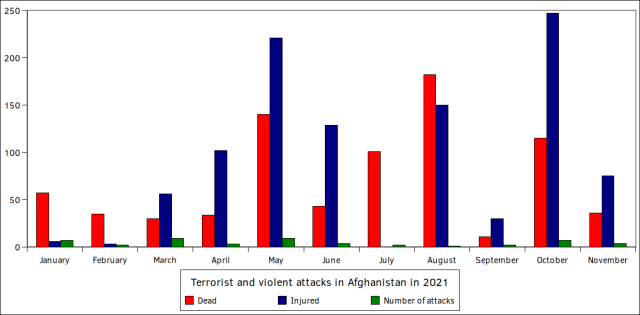Mapping Terrorist and Violent Attacks in Afghanistan in 2021 (Credits: SpecialEurasia, Author: Giuliano Bifolchi)
Geopolitical Report 2785-2598 Volume 13 Issue 11
Author: Giuliano Bifolchi and Silvia Boltuc
SpecialEurasia has monitored terrorist and violent attacks in Afghanistan in 2021 and produced an interactive map to assess which regions are affected mainly by terrorist organisations and analyse how terrorism has evolved or changed since the Taliban’s rise to power.
This year, Afghanistan has faced several problems after the U.S. troops’ complete withdrawal from the country and the Taliban’s rise to power. Terrorism is one of the main threats and challenges in contemporary Afghanistan, and this negative trend seems not to be stopped with the establishment of the Taliban interim Government.
Mapping and monitoring terrorist and violent attacks in the Afghan territory might help to visualise and understand how and where this phenomenon has heavily influenced the life of the local population. For this purpose, we elaborated an interactive map. Even though we collected several sources in different languages and we tried to report all the principal terrorist or violent attacks in Afghanistan and their victims’ numbers, we must admit that it was not possible to mention any single event and also report the correct number of casualties because of lack of information which might produce valuable and solid Intelligence.
In this map, it is possible to monitor terrorist and violent attacks during the entire 2021 in Afghanistan. In black icons, we reported the events before August 15th, 2021, when the Taliban conquered the Afghan capital Kabul. In red icons, we reported terrorist attacks during the Taliban interim Government, which experienced the rise of the Islamic State-Khorasan (IS-K) as one of the most active terrorist organisations in the country.
The map shows which regions and cities were more affected and targeted by terrorist activities. Before the Taliban took power, terrorists mainly organised violent attacks against civilians and the Afghan security forces in the following areas:
- Kabul province (East Afghanistan): the region where the Afghan capital Kabul is located. The province has a multi-ethnic population (Tajiks, Pashtuns, Hazaras, Uzbeks, Baloch, Turkmen, and Hindu) living predominantly in the urban areas.
- Kunduz province (North Afghanistan): it is a tribal area at the Afghan-Tajik borders where different ethnic groups live (Pashtun, Uzbek, Tajik, Turkmen, Hazara, and Pashai). Since 2010, the Kunduz province has become one of the most unstable provinces in Afghanistan due to the Taliban and other terrorist groups’ activities.
- Herat province (West Afghanistan) has a multi-ethnic population that is largely Persian-speaking and borders Iran and Turkmenistan. This region has strategic importance since the Turkmenistan-Afghanistan-Pakistan-India gas pipeline (TAPI) should cross the province and allow Ashgabat’s natural gas export to the east (Gasdotto TAPI tra speranze future e interessi geopolitici).
- Balkh province: it is a multi-ethnic and mostly Persian-speaking (45% Tajik, 25% Hazara) society and borders Tajikistan, Uzbekistan, and Turkmenistan.
- Kandahar province (East Afghanistan) shares borders with Pakistan along the Durand Line (Situazione attuale delle tribù Pashtun lungo la linea di Durand: intervista ad Ahmad Khan Mumtaz). It is mainly inhabited by ethnic Pashtuns, followed by Baloch, Hazaras and Tajiks.
After the U.S. troops’ withdrawal and the Taliban’s rise to power, the main threat to Afghan security seems to be the Islamic State-Khorasan which until now has concentrated its violent attacks in the areas of Kabul Province and the city of Jalalabad in the Nangarhar, which shares an international border with Pakistan.
Terrorism and victims in Afghanistan: interpreting the data

The chart underlines that May 2021 registered the highest number of terrorist attacks (nine), which caused 140 dead and 221 injured. Considering that in April 2021, U.S. President Joe Biden announced the entire troops’ withdrawal from Afghanistan on May 1st, 2021, the rising number of terrorist attacks in May might be interpreted as the Taliban’s strategy to exert pressure on Washington and its allies.
The violent attack at the gate of the Kabul International Airport in late August marked the rising of the Islamic State-Khorasan’s terrorist campaign in Afghanistan against foreign personnel, Afghan civilians and the Taliban. The chart highlights that since August 2021, Afghanistan has experienced 14 terrorist attacks, which caused more than 300 victims and around 500 wounded.
Analysing the targets and the characteristics of the terrorist attacks, it seems that the Islamic State-Khorasan mainly attacks the Taliban, and the Shiite Hazara considered kuffār (plural of kāfir, ‘infidel, disbeliever). Although different terrorist groups are more and less active in Afghanistan and Central Asia (Dilemma of Central Asian Jihadists between IS-K and Taliban), as the Afghan Ambassador in Italy, Khaled Ahmad Zekriya, stated, the Islamic State-Khorasan might be interpreted as part of the Taliban movement used to organise terrorist attacks in the country and convince the international public opinion of the necessity to support the current Taliban interim Government (Afghanistan today: between humanitarian crisis and the Taliban rule. Interview with H.E. Khaled Ahmad Zekriya, Ambassador of Afghanistan in Italy).
Last update: November 26th, 2021
We will deeply discuss security problems and terrorist threats in Afghanistan and, in general, in the entire Eurasia during our Webinar “Sicurezza e minaccia terroristica nello scacchiere geopolitico euroasiatico” organised on December 16th, 2021. For further information and risk analysis on Afghanistan and Eurasia, don’t hesitate to get in touch with us at info@specialeurasia.com.



